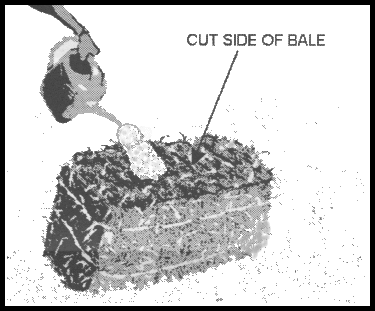Control of Organic Dusts from Bedding Choppers in Dairy Barns
1997
DHHS (NIOSH) Publication Number 97-103
Hazard
Farmers use bedding choppers to chop bales of hay or straw for dairy cow bedding. The chopping of bedding material is hazardous because it is usually made of low quality straw or hay that contains high levels of microorganisms such as bacteria or fungi. These microorganisms are released into the air during the chopping process creating a respiratory exposure hazard. The chopping of bedding materials places the farmer at risk for acute and chronic respiratory and systemic health problems such as asthma, chronic bronchitis, hypersensitivity pneumonitis, and organic dust toxic syndrome. Bedding choppers powered by gasoline engines present an additional hazard because they produce carbon monoxide, a poisonous gas.
Controls
Wet Chopping
- During bedding chopping, worker exposure to airborne organic dusts has been reduced 80% by adding small quantities of water to the bales of hay and straw before chopping. Since the bedding had low levels of moisture, the addition of water was acceptable to the farmers. The wet chopping method involves adding approximately 1 to 2 pints of water to the cut side of the bale immediately before chopping. A small sprinkling can is used to distribute moisture throughout the bales (See ILLUSTRATION).
Substitution/Respiratory Protection
- Significant dust exposures can still occur during wet chopping. Additional controls may be needed depending on the quality of the hay used for chopping. Bales of hay that are visibly moldy (indicating severe contamination by microorganisms) pose the greatest exposure risk. Substitution of less contaminated hay for bedding chopping is recommended. When substitution is not possible, the use of respiratory protective equipment (respirators) is recommended. A comprehensive respiratory protection program (including worker evaluation, selection of appropriate respirators, respirator fit-testing, training, and maintenance) will be needed to provide optimum protection for exposed workers.
Bedding Choppers/Barn Ventilation
- All gasoline-powered engines produce carbon monoxide. The use of pressure-washing units powered by gasoline engines inside agricultural buildings has caused many cases of carbon monoxide poisoning and fatalities. Gasoline-powered bedding choppers are also hazardous, even though they are used for short time periods. They should be used only in well-ventilated barn areas to prevent carbon monoxide poisonings. Electrically powered bedding choppers are available and may be a better overall solution.
Illustration: Water Control Method for Bedding Choppers

*NIOSH is the Federal Agency responsible for conducting research and making recommendations for preventing work related illness and injuries. Hazard Controls are based on research studies that show how worker exposure to hazardous agents or activities can be significantly reduced.
Acknowledgments
The principal contributors to this issue of HAZARD CONTROLS are Greg Kullman, Chris Piacitelli, John Parker, and Jerome Flesch of NIOSH and John May of the Northeast Center for Agricultural Medicine and Health.
This document is in the public domain and may be freely copied or reprinted. NIOSH encourages all readers of this HAZARD CONTROLS to make it available to all interested employers and workers.
Control of Organic Dusts from Bedding Choppers in Dairy Barns
